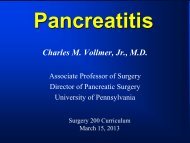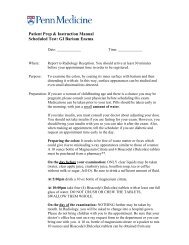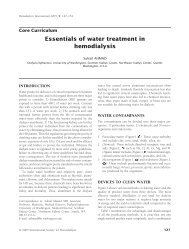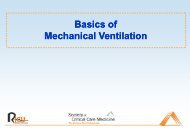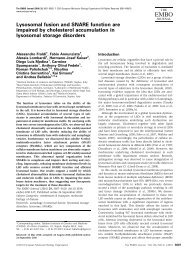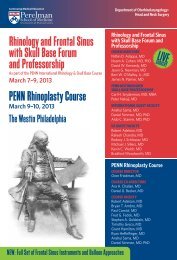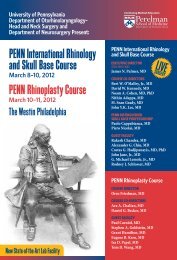Chairman's Note - Penn Medicine - University of Pennsylvania
Chairman's Note - Penn Medicine - University of Pennsylvania
Chairman's Note - Penn Medicine - University of Pennsylvania
Create successful ePaper yourself
Turn your PDF publications into a flip-book with our unique Google optimized e-Paper software.
hiStOry<br />
OtOrhinOlaryngOlOgy - head and neck Surgery at the univerSity Of <strong>Penn</strong>Sylvania<br />
cOrner<br />
Otorhinolaryngology–Head and Neck<br />
Surgery at the <strong>University</strong> <strong>of</strong> <strong>Penn</strong>sylvania<br />
The Evolution <strong>of</strong> a Specialty Continued...<br />
—A Journey to One United Department<br />
From its earliest days, the Department <strong>of</strong><br />
Otorhinolaryngology-Head and Neck<br />
surgery has been shaped by a coterie <strong>of</strong><br />
some <strong>of</strong> the most respected clinicians,<br />
researchers, and educators in the world.<br />
Originally founded in 1870, the<br />
Department’s current structure was<br />
established in the year 1924 with the<br />
appointment <strong>of</strong> George Fetterolf, MD<br />
as the first Chairman <strong>of</strong> the combined<br />
Department <strong>of</strong> Otorhinolaryngology.<br />
Further modifications <strong>of</strong> departmental<br />
structure have been made over time by<br />
multiple Chairmen. The changes made<br />
were dependent on clinical, technological,<br />
and research growth within the specialties<br />
<strong>of</strong> Otorhinolaryngology, Human<br />
Communication, and Head and<br />
Neck Surgery.<br />
1870-1890<br />
George Strawbridge, MD,<br />
Pr<strong>of</strong>essor and Chairman <strong>of</strong> the<br />
Department, then called<br />
Diseases <strong>of</strong> the Ear<br />
6 WWW.uPhS.u<strong>Penn</strong>.edu/<strong>Penn</strong>Orl<br />
The Birth <strong>of</strong> the Graduate School<br />
<strong>of</strong> <strong>Medicine</strong> <strong>of</strong> the <strong>University</strong> <strong>of</strong><br />
<strong>Penn</strong>sylvania 1918-1965<br />
The Carnegie Foundation for the<br />
Advancement <strong>of</strong> Teaching’s Abraham Flexner<br />
report <strong>of</strong> 1910 described the confused<br />
pattern <strong>of</strong> medical education in Philadelphia.<br />
The city’s multiple medical schools and<br />
general hospitals provided good clinical<br />
training for residents, but frequently did not<br />
provide adequate experience in the basic<br />
aspects <strong>of</strong> the specialties. A need existed for<br />
combined specialized scientific and<br />
laboratory training in conjunction with<br />
residency—(a Graduate School <strong>of</strong><br />
<strong>Medicine</strong>). The report recommended a<br />
broader merger scheme.<br />
In 1918, an alternative unique institution for<br />
graduate training in medical specialties<br />
evolved as the Graduate School <strong>of</strong> <strong>Medicine</strong><br />
1890-1905<br />
Burton Alexander Randall,<br />
MD, PhD, Pr<strong>of</strong>essor and Chair<br />
<strong>of</strong> Diseases <strong>of</strong> the Ear; from<br />
1905 to 1925 he was Pr<strong>of</strong>essor<br />
and Chair <strong>of</strong> the<br />
Department <strong>of</strong> Otology<br />
1905-1926<br />
Charles P. Grayson, MD,<br />
Pr<strong>of</strong>essor and Chairman <strong>of</strong><br />
Laryngology and Rhinology<br />
(GSM) <strong>of</strong> the <strong>University</strong> <strong>of</strong> <strong>Penn</strong>sylvania.<br />
This resulted from a merger <strong>of</strong> the Medico-<br />
Chirurgical Medical School, founded in<br />
1867, and the Philadelphia Polyclinic and<br />
College for Graduates in <strong>Medicine</strong>. Due to<br />
interruptions caused by World War I, this<br />
new department did not begin to <strong>of</strong>fer<br />
courses until the 1919-1920 academic year.<br />
The Graduate School <strong>of</strong> <strong>Medicine</strong> (GSM)<br />
was generally regarded as the prime training<br />
center in the United States for<br />
otolaryngologists and <strong>of</strong>fered Master’s <strong>of</strong><br />
Science and Doctors <strong>of</strong> Science degrees in<br />
Otolaryngology.<br />
From 1919 to 1953, Otolaryngology was<br />
represented in the Graduate School by two<br />
different Departments, Otology and<br />
Laryngology. From 1919 to 1933, George M.<br />
Coates, MD served as Head <strong>of</strong> the<br />
Department <strong>of</strong> Otology and George Wood,<br />
MD was the Head <strong>of</strong> the Faculty in<br />
1926-1933<br />
George Fetterolf, MD, the first<br />
Chairman <strong>of</strong> the<br />
combined Department <strong>of</strong><br />
Otorhinolaryngology<br />
1934-1940<br />
George M. Coates, MD,<br />
Pr<strong>of</strong>essor and Chairman<br />
<strong>of</strong> Otolaryngology



